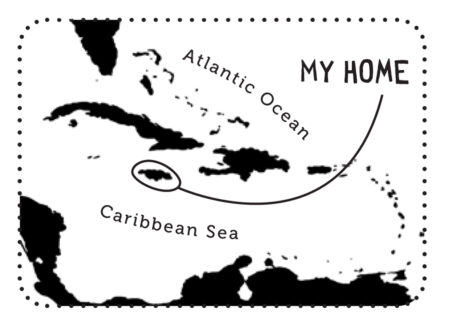Celebrate the Caribbean Endemic Bird Festival (CEBF) with us! Our theme in 2025 is “Shared Spaces: Creating Bird-friendly Cities and Communities”—highlighting the crucial role bird-friendly cities and communities can have in addressing the decline in bird populations caused by threats like habitat loss, predation, and climate change. Have fun learning about a new endemic bird every day. We have colouring pages, puzzles, activities, and more. Download for free and enjoy learning about and celebrating nature!
Endemic Bird of the Day: Jamaican Oriole
“Auntie Katie! You-cheat, you-cheat-you, you-cheat-you and If-you-want-it-free, don’t-ask-me!”
These whimsical lyrics mimic the melodious song of the Jamaican Oriole (Icterus leucopteryx leucopteryx), known locally as Auntie Katie, Banana Katie, or Banana Bird.
This medium-sized songbird, about 20 cm long, fills the air with its rich, flute-like whistles—especially in the early morning and late afternoon. Its song, made up of rapid, down-slurred patterns, adds a bright, musical flair to Jamaica’s natural soundscape.
The Jamaican Oriole is unmistakable with its bold contrast of yellow and black. It sports a black throat, face, and upper chest; a greenish-yellow head, nape, and mantle; and a vibrant yellow belly and rump. Its wings and tail are mostly black, with a large white patch on the wing patch. Females look similar but slightly duller, while immatures are olive-green with less black on the head and dusky green tails.
These adaptable birds thrive in all kinds of habitats—from forests at all elevations to gardens and towns. They’re omnivores with a sweet tooth, often seen in fruit trees feasting on bananas, mangoes, Otaheite apples, and papayas. They also enjoy the nectar provided by flowers—and will eagerly tear flowers apart to get to their nectaries. These resourceful birds also feed on insects—using their pointy beaks to probe into tree bark, bromeliads, and seed pods, or picking prey right off leaves.
Jamaican Orioles are also nature’s engineers, weaving hanging pouch-like nests out of grass, thread, fibers, and Spanish moss. These nests sway beneath tree branches and are cleverly hidden among the leaves to protect chicks from predators. Females typically lay 3–5 white eggs with brown markings, and both parents pitch in to feed and care for their young.
Although the Jamaican Oriole is currently listed as Least Concern by the IUCN, it still faces challenges. Habitat loss from deforestation and poorly planned urban expansion threatens its future. It also falls victim to the invasive Shiny Cowbird (Molothrus bonariensis), a brood parasite that lays its eggs in oriole nests, tricking orioles into raising cowbird chicks instead of their own. Planting native trees, preserving green spaces, and supporting local conservation efforts are great ways to help this charismatic bird continue to thrive.
While the Jamaican Oriole subspecies (Icterus leucopteryx leucopteryx) is found only in Jamaica, a related subspecies occurs on San Andrés, Colombia. Sadly, the species is now extinct on Grand Cayman.
The Jamaican Oriole also holds a special place in the island’s birding culture—it appears on the logo of the Gosse Bird Club, founded in the 1950s, and which continues today as BirdLife Jamaica. Learn more about this species, including its range, photos, and calls here. Great news! If you’re in the Caribbean, thanks to BirdsCaribbean, you have free access to Birds of the World and you can find out even more in the full species account of this bird!
Thanks to Arnaldo Toledo for the illustration and Damany Calder for the text!
Colour in the Jamaican Oriole
Download our West Indies Endemic Bird colouring page. Use the photos below as your guide, or you can look up pictures of the bird online or in a bird field guide if you have one. Share your coloured-in page with us by posting it online and tagging us @BirdsCaribbean #CEBFfromthenest
Listen to the song of the Jamaican Oriole
The song of the Jamaican Oriole is series of rich, whistled, and slurred phrases and “cheat-you, cheat-you, cheat-you, cheat-you, cheat.”
Puzzle of the Day
Click on the image below to do the puzzle. You can make the puzzle as easy or as hard as you like – for example, 6, 8, or 12 pieces for young children, all the way up to 1,024 pieces for those that are up for a challenge!
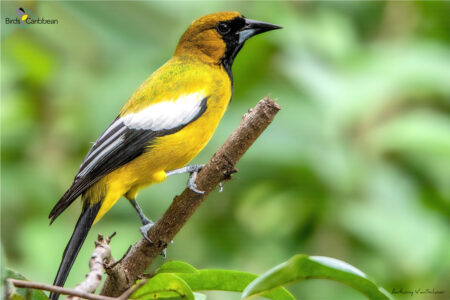
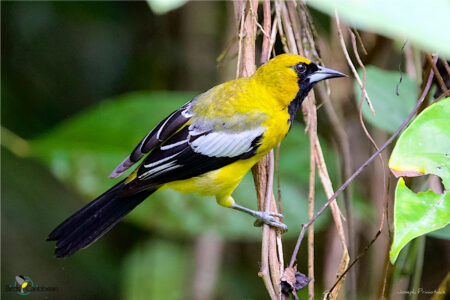
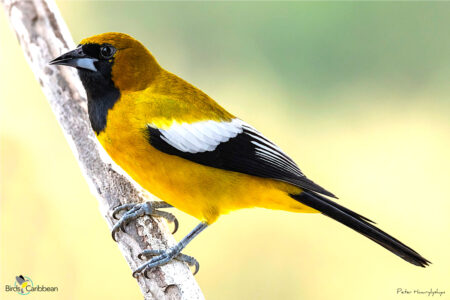
Activity of the Day
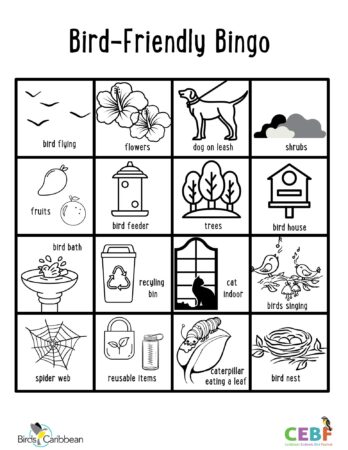 FOR KIDS : Get ready to head out on a bird-friendly adventure with our bird-friendly bingo game! Ask a trusted adult if you can take a walk in your backyard, or go with them on a walk around your neighbourhood. As you walk around look carefully for things that help keep birds safe in your community. You can then mark them off on the bingo card we provide in our game! Get out there and see what you can find!
FOR KIDS : Get ready to head out on a bird-friendly adventure with our bird-friendly bingo game! Ask a trusted adult if you can take a walk in your backyard, or go with them on a walk around your neighbourhood. As you walk around look carefully for things that help keep birds safe in your community. You can then mark them off on the bingo card we provide in our game! Get out there and see what you can find!
FOR KIDS AND ADULTS : Enjoy this video of a Jamaican Oriole in the wild!


